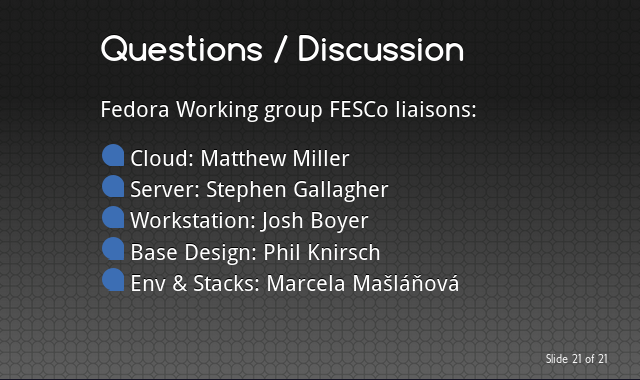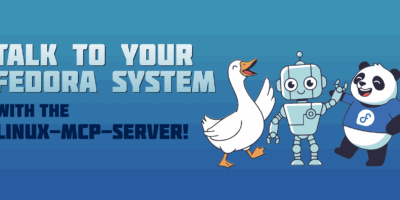This is the continuation of part four of a series based on talks at February at DevConf in the Czech Republic. I was going to cover all of the reports from each of the Working Group liaisons in one post, but that turned out to be quite a wall of text, so I’m going to do them one by one, with Josh Boyer from the Fedora Workstation Working Group this week.
You should start with Part I, ”Why?”, and if you enjoy the general concepts of “logical progression” and “putting the horse before the cart”, I suggest following that with Part II, “What’s Happening?” and then Part III, “Governance, Progress, and More Ideas”.
If you missed the previous Working Group reports, they’re at Part IV, a, b, and c; Base Design, Environments and Stacks, and Fedora Server.
You can watch the video on YouTube, but you may find the text more helpful. I’ve summarized and paraphrased instead of just transcribing. And, since it has been three months, I’ve gotten updates from each speaker.
Working Group Report Video
Fedora Workstation: Josh Boyer
Josh says that representing the Fedora Workstation Working Group is both an honor and a curse. The Workstation product is the closest to the traditional Fedora desktop distribution that everyone is used to. This is an advantage, because everybody kind of understands it, and has their own ideas and formulations of what they think a "workstation" is. But it’s also a disadvantage for the exact same reason.
Everybody has their favorite desktop environment, whether it’s GNOME, or KDE, or Xfce, or whatever. Josh explains that, while they’re all good — and none is better than another — the idea behind Workstation is that we want to ship something that’s consistent; that works for people who are developing things for Server, for Cloud, and for whatever future products we might need. We want to have a consistent set of APIs, and make the platform a little more friendly to third-party developers — not necessarily ISVs, but certainly including them. Docker plays into it a little bit, and there are other approaches with containerized apps, but the foundation for that is having a workstation that just works. That’s what the Workstation Working Group is focusing on.
Because of all of this, Fedora Workstation has been the most debated product going forward so far. Josh says that it’s been good debate, with a lot of discussion, although there has also been a lot of miscommunication and misunderstanding, so he hopes that this presentation and panel discussion and further on, we can get the questions people have answered in a way that makes sense going forward.
Josh says that personally, he thinks that if you’re going to develop the cool, exciting stuff that isn’t the "boring OS", you need a stable development platform to use for everything else you want to do, instead of focusing on maintaining your own workstation.
Update: Fedora Workstation Working Group member Christian Schaller has a long blog post titled Preparing the ground for the Fedora Workstation, which gives additional background and perspective.
Visit the Workstation Working Group page on the Fedora Project wiki for further information, including the mailing list and IRC channel.
Watch for the final section of Part IV Next Week
Coming up, the summary the Cloud product working group. And then, once the summary presentations are done, it’s on to Q&A.
As before, let’s continue this conversation in comments and replies, and in addition to responding, I’ll distill that into a final FAQ post at the end of this series (separate from the summary of the questions at the conference).





